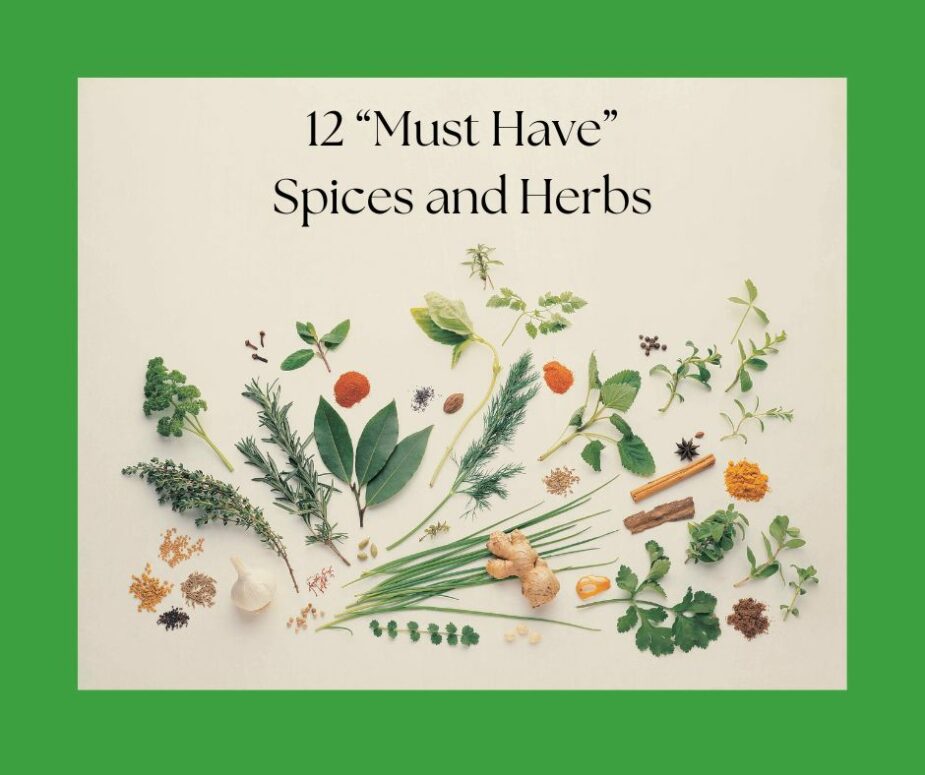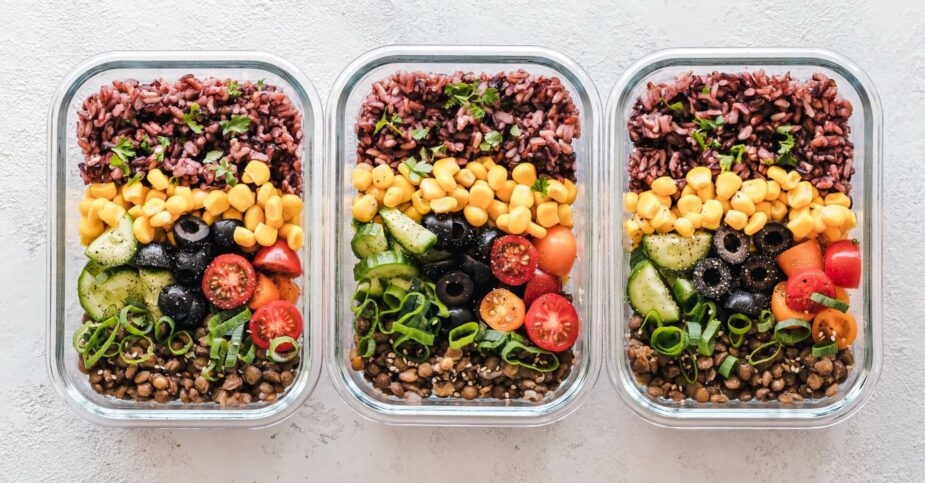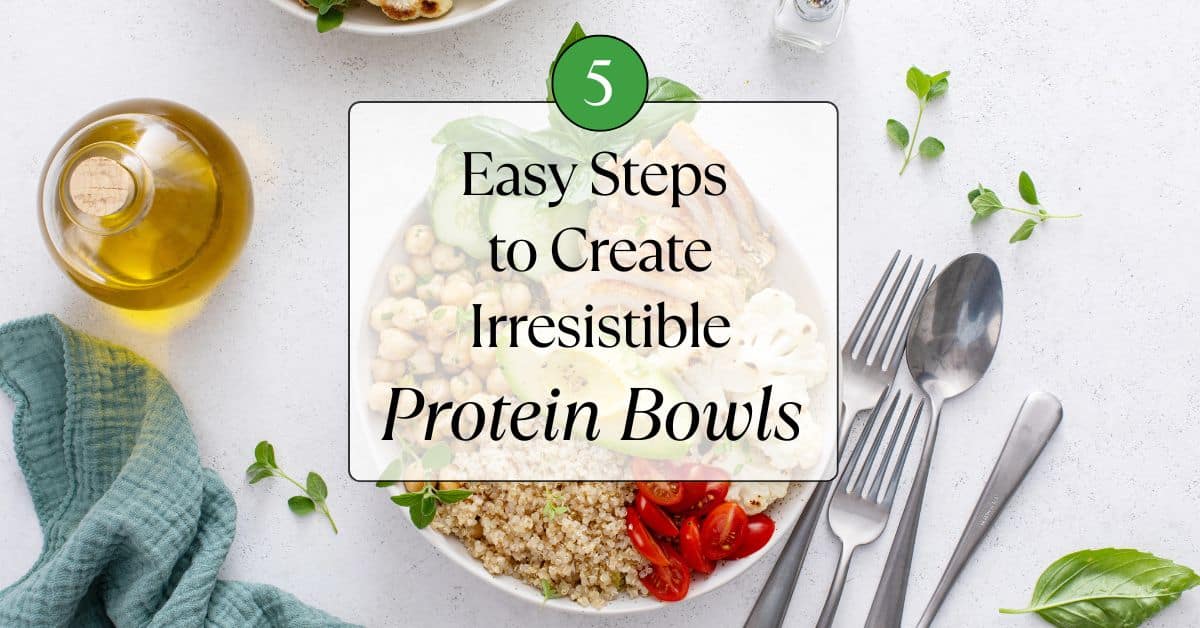Have you ever noticed how just a dash of basil or a sprinkle of cinnamon can transform a recipe from just ordinary to amazing? Cooking with herbs and spices not only helps add flavor and vibrancy to our meals but they can also help cut back on how much extra salt and sugar you use in your cooking.
Now, I know – It’s so easy to fall into a cooking rut, relying on the same few ingredients and recipes. But with a well-stocked spice rack, you can bring new life to your dishes, adding depth, aroma, and a new adventure to every bite.
But, you don’t need to buy every spice lining the grocery store shelves…or have a garden full of herbs – although, that does sound kind of wonderful, doesn’t it?
In this blog post, I’ll take you through 12 essential herbs and spices that I think every home cook should have on hand. All those little jars and plants lining your windowsill or garden pack a punch. They will enhance the taste of your food and give you a host of health benefits.
From the robust warmth of cinnamon to the refreshing zest of basil, let’s explore why I think each of these herbs and spices is a must-have. You’ll also find some of my favorite ways to use them and tips on how to use them.
Get ready to elevate your culinary game and make your meals more exciting and nutritious with these 12 indispensable herbs and spices. Let’s spice things up!
Table of Contents
12 Common Herbs and Spices to Have on Hand
These 12 common herbs and spices are the ones I recommend everyone stock in the spice cabinet.
Aside from their incredible flavor and ability to transform a recipe, each has some amazing health benefits too. I won’t dive too deeply into that – you can read more in my article about the 7 Health Benefits of Cooking with Herbs and Spices.
Note: Use this article as a resource! Scroll through it to find the herb or spice you are most interested in learning about and then bookmark this page to reference later. There’s a lot of information packed in here!
I’m working on an herb and spice guide – keep your eyes peeled. In the meantime – let’s dive in.
1) Basil
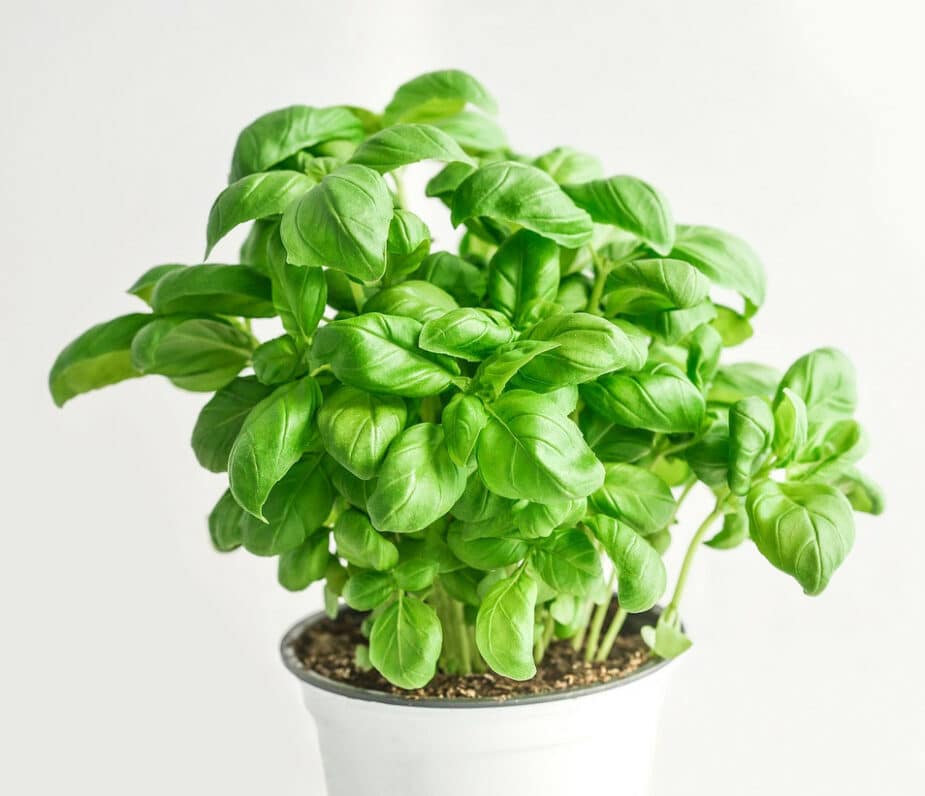
Image by Monika from Pixabay
First up, and a spice I use almost daily is basil. Whether a dash of dried basil in tomato sauce for pasta or mixed with vegetables, or a chiffonade of fresh basil from our backyard sprinkled over our Friday night pizza, this is one herb I can’t do without.
Sweet or Genovese Basil are traditionally used in Italian and Mediterranean dishes. These both have a bright green color, green stem, and sweet basil flavor.
But many other types of basil are fun to try. Two others that I often have in my herb garden are:
Thai Basil is also commonly found in many Asian dishes. I often have one growing in my backyard in the summer. It tastes a bit like fennel, or anise and the leaves are not as delicate. Add this to a stir fry or Thai curry.
Purple Basil has leaves shaped similarly to Thai basil and has a dark purple color. It has a spicier flavor than the other two. Some people describe its flavor as similar to cloves, but I find them to have a bit of a bite. I add a few of these leaves to salads for an unexpected flavor burst.
Like other leafy greens basil contains a significant amount of vitamin K and the essential oils (which is where it gets its gorgeous aroma and flavor) are rich in antioxidants.
What to use basil in:
- Fresh basil in salads and sandwiches
- Basil pesto for pasta
- Garnish for soups, pizza, bruschetta or crostini
- Stir into pasta sauce
- Add to salad greens for a herby flavor
- Add a sprig to a cocktail or mocktail .
- It adds an unexpected, herby note to a cool glass of lemonade!
2) Black Pepper
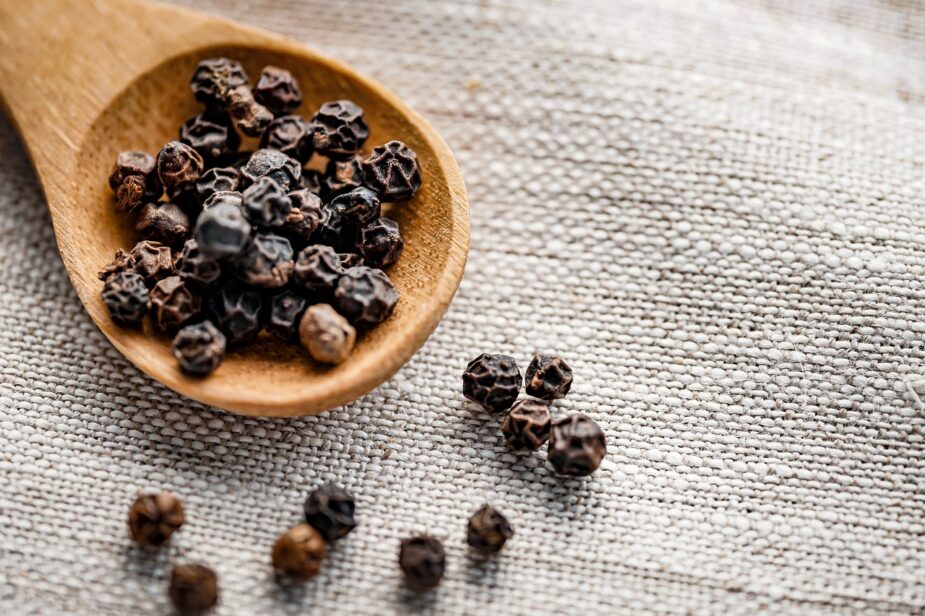
Image by Kai Reschke from Pixabay
This staple is probably on every kitchen table in America and has the nickname, “the king of spices.” Like salt, it was considered extremely valuable and used to pay taxes and other debts in ancient times.
Today, while you can buy a container of ground black pepper or whole peppercorns for a couple of dollars at the grocery store, it is still one of the most valuable spices in your kitchen.
My pepper grinder is always nearby and I use it daily to season, chicken, meat, fish, and vegetables. It’s lovely ground fresh over a salad just before serving.
The ingredient called piperine gives these peppercorns their spicy flavor and is the compound that provides its potential health benefits. Piperine may help boost our brain function, protect our GI tract, help with digestion, and protect us from infection.
What to use black pepper in:
- Seasoning meats, chicken, and fish before cooking
- Sprinkle over roasted vegetables and potatoes
- Add to salad dressings and marinades
- Season soups, casseroles, stews
- Add peppercorns to chicken, vegetable, or beef stock while it’s cooking
- Add it to bread dough for a savory, spiced bread
- Just about every dish will benefit from a sprinkle of black pepper!
3) Cayenne Pepper
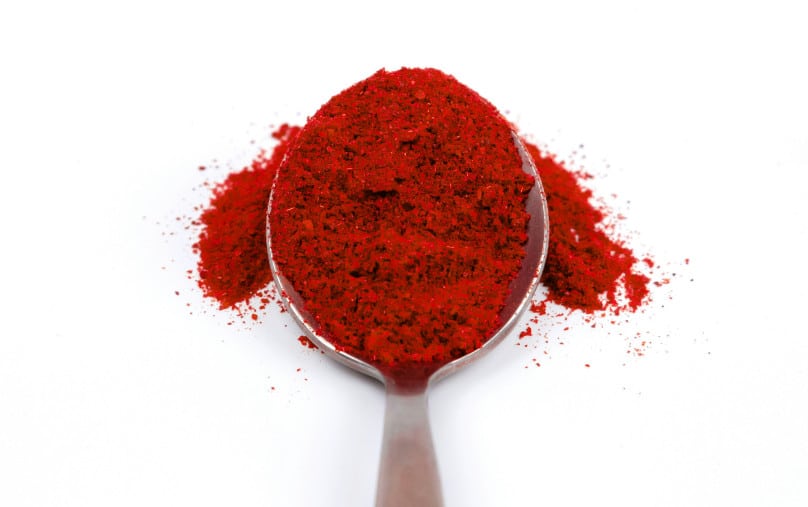
Image by Volodymyr Hryshchenko on Unsplash
With a bit more of a kick than black pepper, cayenne pepper comes from a dried chili pepper which is then ground into a powder. Cayenne pepper is a much spicier, hotter pepper than black pepper and gets its heat from a compound called capsaicin.
Capsaicin has several potential health benefits including pain relief and improved digestion. Some research found using cayenne pepper helped reduce the use of salt and increased feelings of satiety after eating a meal.
What to use cayenne pepper in:
- Add it to salsas, marinades and sauces
- Sprinkle on eggs and avocado toast
- Mix it with other spices to make your own taco seasoning
- Add a dash to soups or stews – especially good in Chicken Tortilla Soup!
- Add a sprinkle to hot chocolate for a spicy kick
4) Cinnamon
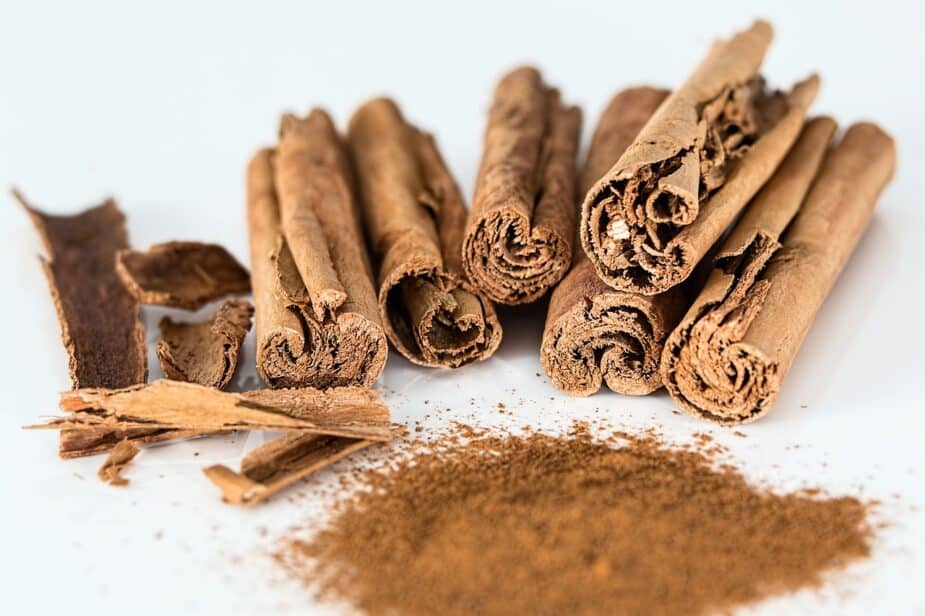
Image by Steve Buissinne from Pixabay
Usually thought of as a sweeter spice, cinnamon can be used in everything from pumpkin pie and cinnamon rolls to more savory dishes including pork roast and chili. It is also delicious added to hot chocolate, and iced coffee. For a treat, try adding a little to your coffee grounds before brewing.
Cinnamon comes from the inner bark of cinnamonum trees. The flavor comes from a compound called cinnamaldehyde, which may also be responsible for its ability to reduce microbial growth and act as a preservative.
Cinnamon is also rich in antioxidants and phytochemicals which may help protect against Alzheimer’s disease and heart disease. However, the main health benefit it has become known for is its potential to help with blood sugar control.
What to use cinnamon in:
- Sprinkle on oatmeal and yogurt
- Add to smoothies and baked goods
- Sprinkle it on hot chocolate and coffee
- Use in curries and savory dishes
- Add a dash to chili and pot roast
5) Ginger
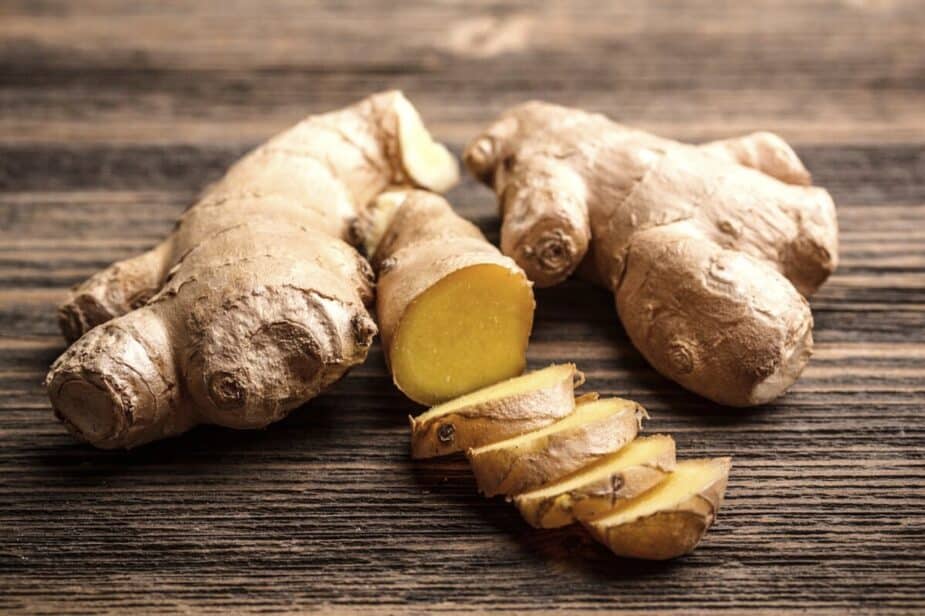
Image by Joseph Mucira from Pixabay
I love the unexpected spice or “bite” you get from ginger. Whether sipping on ginger tea or enjoying the bite it adds to teriyaki sauce, this is one of my favorite secret ingredients. I use it in marinades and curries but have also infused it into olive oil for salad dressings or to drizzle it on pork tenderloin before cooking.
You can use fresh ginger root and shave or slice off pieces, powdered ginger, or even dried ginger in some things.
It does help reduce inflammation and is often used to help relieve nausea. Yup, your mom gave you ginger ale for an upset stomach for a reason! And ginger tea and ginger drops were things I often recommended to my patients who were going through chemotherapy as a way to alleviate some of their symptoms.
What to use ginger in:
- Fresh ginger in teas and smoothies
- Add to stir-fries and soups
- Slice fresh ginger and toss it into salads and coleslaw
- Cookies and cakes
- Make a ginger simple syrup – and use it in cocktails or iced tea
- Roast with vegetables – broccoli and carrots work well
- Mix it into salad dressings and dips – Try my White Balsamic Ginger Vinaigrette for salads or as a marinade.
- Add a sprinkle of ground ginger to your coffee grounds before brewing
6) Mint
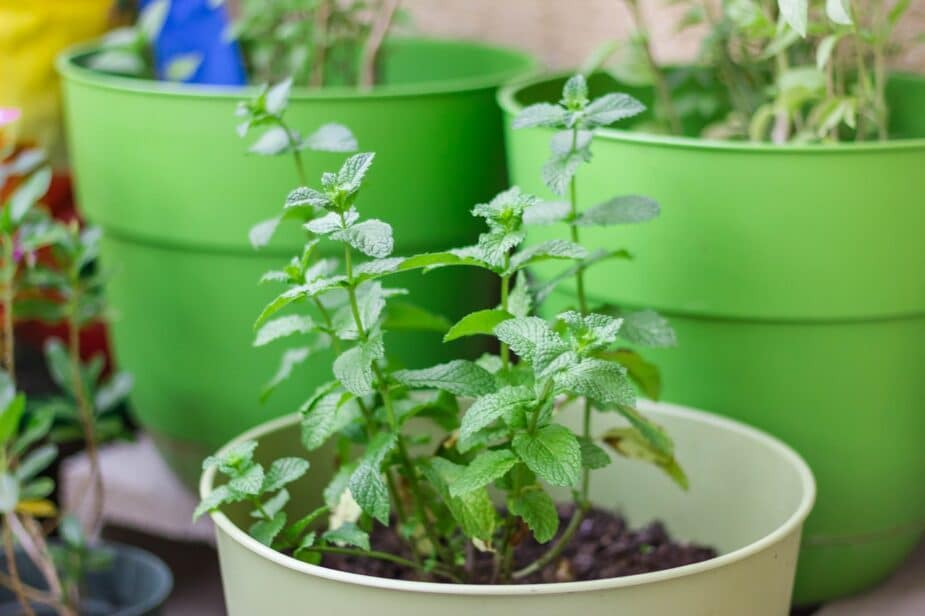
Image by Ajaydev Singh from Pixabay
This sweet herb is probably most associated with a mint julep or mint jelly that is served with roasted meat, often lamb, but mint is delicious in salads, teas, lemonade, or other cool dishes.
You’ll get the most flavor by using fresh mint vs. dried. I keep a pot or two in my herb “garden” every year and use it in iced tea, herbed salad, and in tabbouleh – just to name a few. I will also clip a few leaves and freeze them with water to make mint ice cubes. I love the flavor and it makes drinking water so much more fun!
Mint is thought to help with digestion and may help alleviate nausea. It is also full of antioxidants which can help decrease inflammation.
One last thing – I don’t recommend planting it in beds in your flower or herb garden. While it has a lovely scent, it will spread everywhere! Keeping in a pot like the picture above is the best way to grow it.
What to use mint in:
- Fresh mint in salads and smoothies
- Add to water and tea
- Freeze it in ice cube trays with water and use it to brighten your water or lemonade
- Chop it and add it to salad dressings for a fresh flavor
- Add it to a marinade for pork or lamb
- Garnish for desserts and drinks
7) Nutmeg
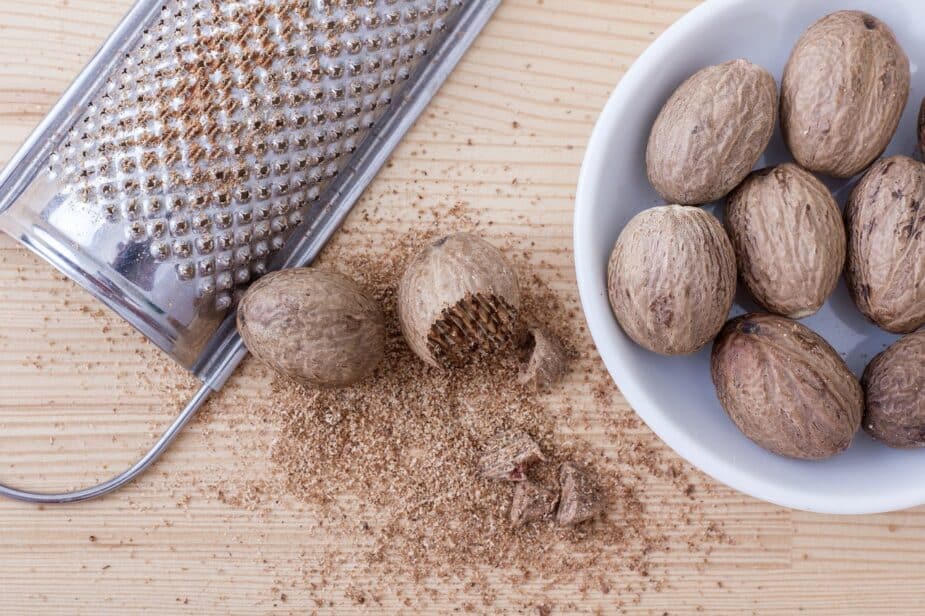
Image by scym from Pixabay
When someone mentions “nutmeg”, can’t you just picture yourself curled up with a blanket and a good book, a cup of cocoa, and a spiced cookie or pumpkin bar? It does have a comforting feeling, doesn’t it?
This earthy spice is one of my fall “go-tos” – but I use it more often than just in those cool months. I use it throughout the year in coffee and tea and creamy dishes. It is known to help with digestion and while more studies are needed, it appears to help reduce inflammation so may help protect your heart and brain health.
You can buy it as a whole seed and grate it fresh. These “seeds” are more like nuts and will last for a few years in your pantry. I keep a little nutmeg and ginger grater nearby and grate it fresh. The flavor is amazing. You can also buy ground nutmeg, which is much easier to use when making cakes and cookies!
What to use nutmeg in:
- Mix it into dough for cookies, cakes, and pumpkin or sweet potato pie
- Grate it into coffee grounds before brewing
- Mix it with softened butter to use on sweet potatoes
- Add it to cream sauce and egg dishes
- Use in beverages like hot cocoa and chai tea
8) Oregano
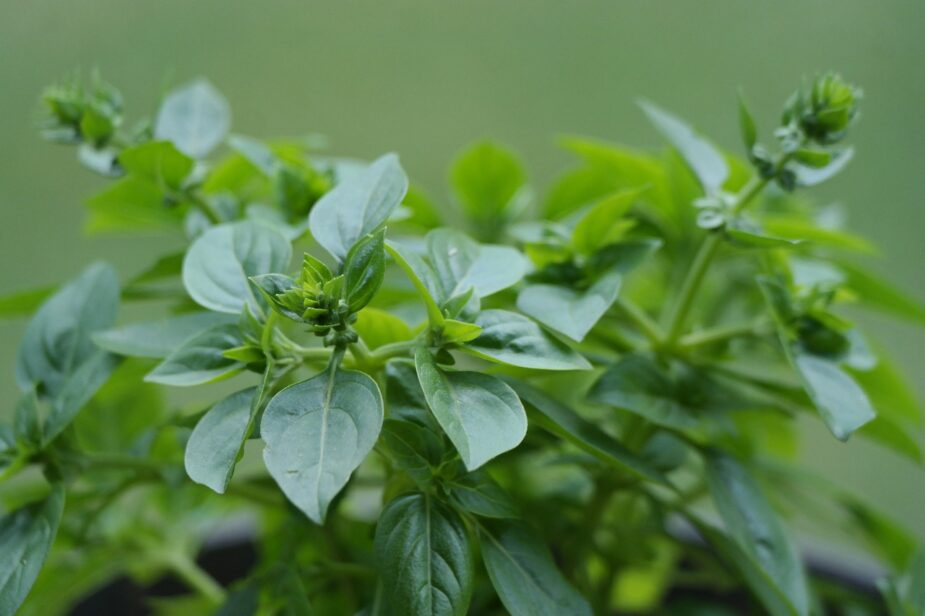
Image by Redbud Patriot from Pixabay
Oregano has a pretty distinct flavor – kind of earthy and often it has a bit of a peppery or spicy bite. Harold Magee, who wrote the classic book, “On Food and Cooking: The Science and Lore of the Kitchen” calls oregano the “The Joy of the Mountains.” Most likely because it grew along mountainsides throughout the Mediterranean and had such a strong aroma.
Because fresh oregano has such a strong flavor, many people prefer using dried oregano because the flavor is a bit more mellow.
I think there is a place for both and always have a planter with oregano in my herb garden during the summer but then also keep a good supply of a couple of kinds of dried oregano (Greek and Mexican) in my spice cabinet.
Oregano contains both flavonols and phenolic compounds, which are active compounds that provide an antioxidant and anti-inflammatory effect. Both fresh and dried oregano contain these healthful compounds.
What to use oregano in:
- Go slowly and taste as you go. Oregano can have a strong flavor!
- You can add more as you prepare the dish.
- Before adding dried oregano to food, gently rub between your fingers to release some of that beautiful flavor and aroma.
- Use it as a seasoning for meats and vegetables
- It is a classic in pasta sauces and pizzas
- Sprinkle some chopped, fresh oregano leaves on salads and soups
- Use Mexican oregano with fajitas, enchiladas, and tacos. I add it to my homemade taco seasoning
9) Rosemary
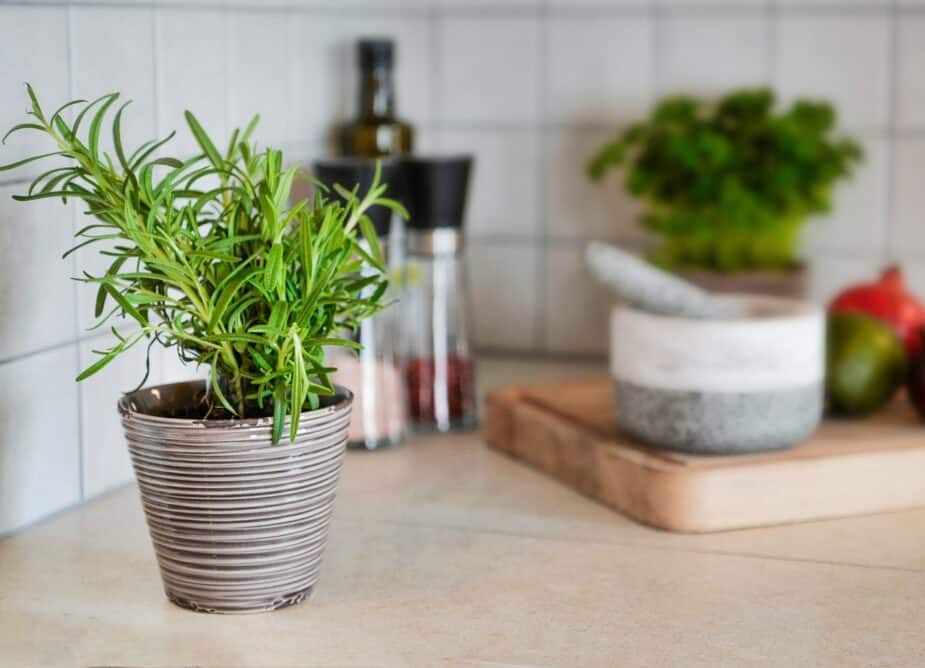
Image by Monika from Pixabay
Rosemary has incredible antioxidant properties and because it can protect against bacterial growth in food its oils are often used to help preserve food. It also has an amazing and almost calming fragrance. It has been used for centuries to treat headaches and “emotional upset.” And it may have some memory-boosting potential too.
Personally, I love the flavor it adds to food – especially roasted meats and potatoes! Toss a tablespoon with olive oil and mix that with red-skinned potatoes, Oh my! Delish!
But there are many other ways you can use fresh and dried rosemary.
Here are some of my favorites:
What to use rosemary in:
- Crush dried rosemary with ground black pepper and rub it on the meat.
- Mix dried rosemary with lemon zest and butter and spread it over a roasting chicken before placing in the oven.
- Add to breads and savory baked goods
- Mix fresh or dried chopped rosemary with olive oil, then toss with vegetables before roasting.
- Infuse in oils and vinegars
- Use long spikes of fresh rosemary in place of wooden skewers for grilled meats and vegetables
10) Sage
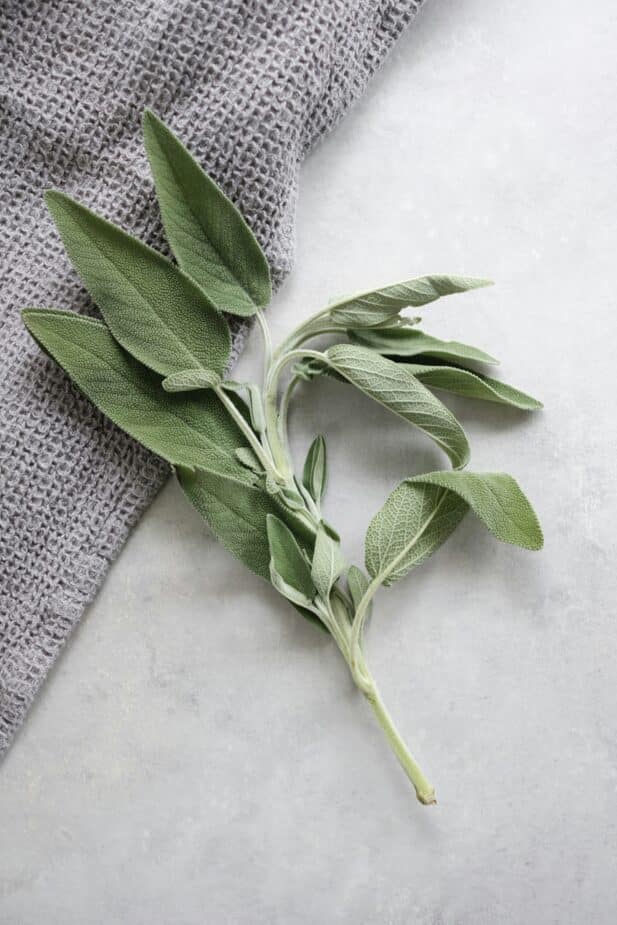
Image by Paulina H. on Unsplash
This is another herb or spice you probably only think about in the fall when you are making stuffing or roasting that turkey. But sage is a spice I think should be pulled out from the depths of your spice cabinet much more often!
Sage has a distinctive, earthy, savory flavor that pairs perfectly with poultry, pork, and vegetables.
The fresh leaves have a soft, fuzzy texture. When you rub them between your fingers an intense aroma emerges. For centuries people have burned sage as a way to lift their mood, clean the air, and promote healing.
Dried sage comes in dried leaves and ground forms. The ground spice mixes easily into sauces and soups and the dried is delicious in stuffings and grain dishes.
Some evidence suggests that sage can help boost our mood, reduce feelings of stress and anxiety, and may help improve our memory and attention span.
What to use sage in:
- Add to stuffing or rice blends
- Season roasted meats and poultry
- Add it to sauteeing apples and serve over a roast pork loin
- Mix it with maple syrup and drizzle it over winter squash or sweet potatoes
- Make a browned butter sauce with onions and sage and use it over butternut squash or pumpkin ravioli
- Use in teas and infusions
11) Thyme
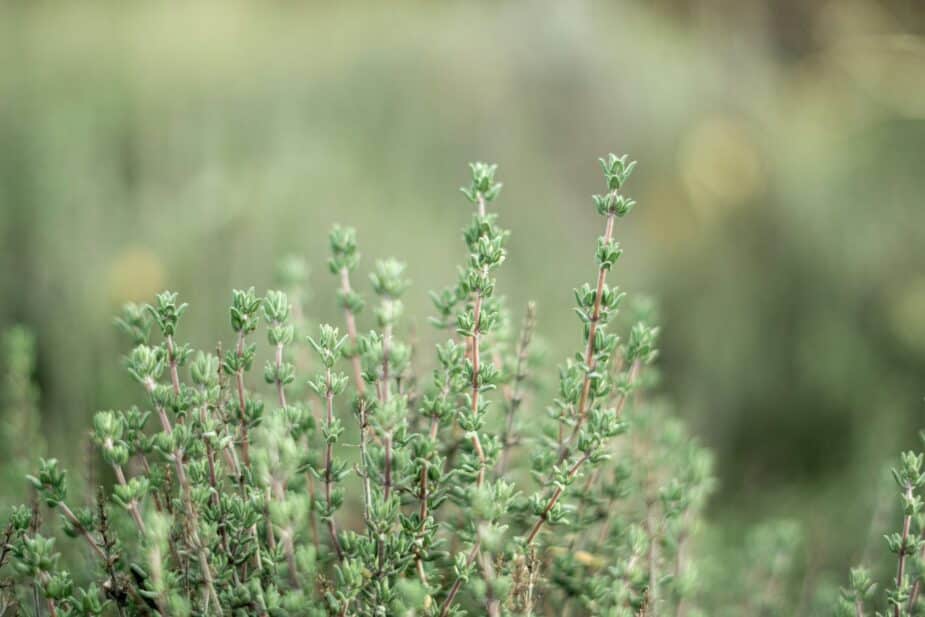
Image by Anja Junghans on Unsplash
This fragrant herb is as delicious as a dried spice as it is fresh. It grows in a variety of climates and is often used as a ground cover or as a filler in rock gardens. There are several varieties of thyme, including French, Lemon, Creeping, and Common Thyme.
In cooking thyme adds an earthy, peppery flavor which some describe as also being a bit bitter.
The type you’re most likely to find in the grocery store is common thyme. You may find it as a dried leaf or ground. If you use the ground version, it’s best to cut the amount the recipe calls for in half. It’s a much more concentrated form of thyme than using the dried leaves.
If you are making a soup or stock, try to add fresh thyme sprigs as much as possible. Add them early in the cooking process and let the flavors infuse throughout the liquid.
I love adding it to delicate white fish, beef stew, hearty grain dishes, and roasted vegetables like my Asparagus Mushroom Saute.
What to use thyme in:
- Add a sprig of fresh thyme to homemade broth or place dried thyme in a small pouch of cheesecloth with peppercorns and submerge it in the broth to infuse.
- Crush dried thyme and sprinkle it over vegetables before roasting or sauteing.
- Sprinkle fresh or dried thyme over fish before baking or add it to the poaching liquid.
- Use in marinades and sauces.
- Add fresh thyme leaves to a green salad for a herb flavor boost.
12) Turmeric
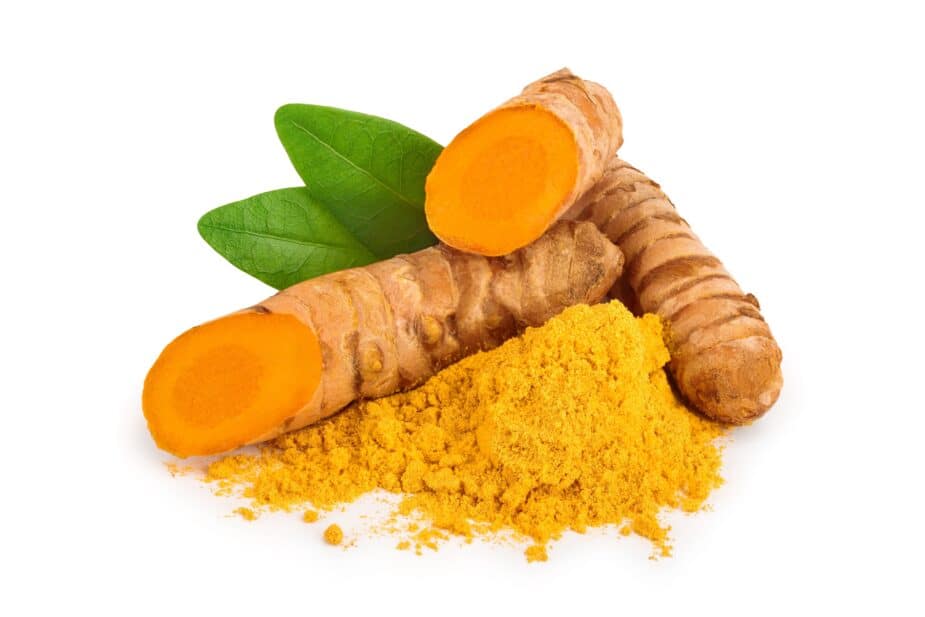
Image by: Kolesnikovserg on depositphotos
Turmeric has become popular recently due to its many potential health benefits. It’s been shown to help reduce inflammation, support joint health, and improve digestion. It contains a compound called curcumin which is what provides those positive benefits. To learn more about all those benefits in my article “7 Health Benefits of Cooking with Herbs and Spices”
For this, let’s talk about how to use this spice because it isn’t something a lot of us don’t cook with often.
This deep yellowish, orange spice comes from a root, called a rhizome, which is similar to how ginger is found. It is native to India, which is why you may think of Indian cuisine when you think of this spice. But it has become much more popular in the U.S. in recent years.
You may see it used in turmeric smoothies, soups, pickles, and even macaroni and cheese. Its bright orange color adds a beautiful tint to grain dishes and marinades. It has a distinct flavor and is often described as peppery with a hint of ginger.
What to use turmeric in:
- Add to curries and soups
- Use in smoothies and golden milk
- Steep fresh turmeric in hot water to make tea
- Sprinkle on roasted vegetables
- Mix it into broth to cook rice or other grains
- Blend it with Greek yogurt and make a marinade for chicken or pork
- Toss a little with vegetables before roasting
The Versatile Power of Herbs and Spices
Incorporating these 12 must have spices and herbs into your kitchen elevates the flavor of your dishes and offers a myriad of health benefits. By using herbs and spices to season your food, you can significantly reduce the amount of sodium and fat in your meals while still enjoying bold and delicious flavors. No compromising on taste or health!
Beyond these 12 must-haves, there is a vast world of spices and herbs out there. While my list focuses on those that provide the most flavor and health benefits per use, don’t hesitate to explore and experiment with other herbs and spices. Each one has its unique properties and can offer new and exciting ways to enhance your meals.
Embrace the journey of discovering new flavors and improving your culinary skills. With these essential spices and herbs, you’ll be well-equipped to make delicious and healthy dishes that impress both you and your guests.

